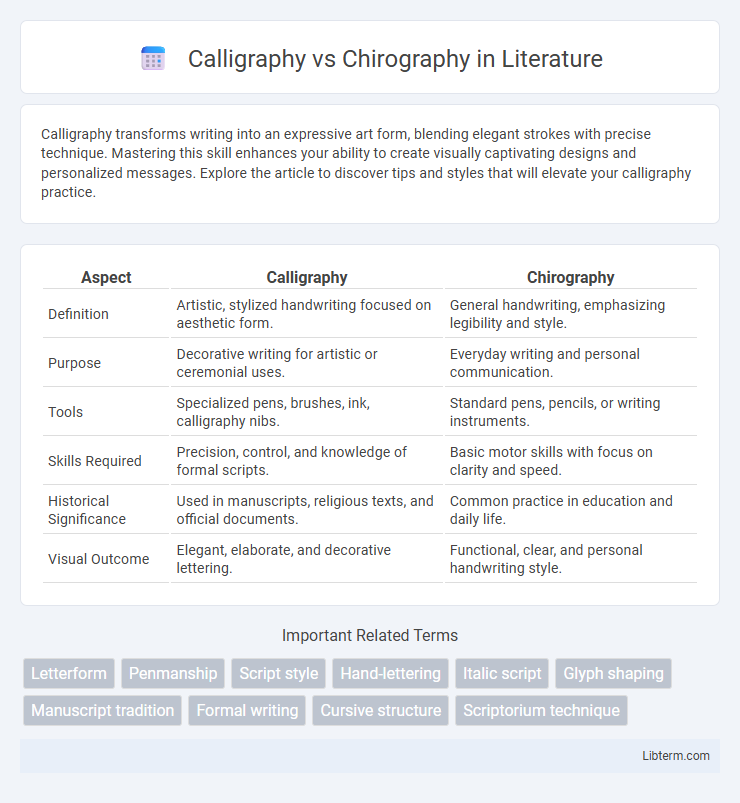Calligraphy transforms writing into an expressive art form, blending elegant strokes with precise technique. Mastering this skill enhances your ability to create visually captivating designs and personalized messages. Explore the article to discover tips and styles that will elevate your calligraphy practice.
Table of Comparison
| Aspect | Calligraphy | Chirography |
|---|---|---|
| Definition | Artistic, stylized handwriting focused on aesthetic form. | General handwriting, emphasizing legibility and style. |
| Purpose | Decorative writing for artistic or ceremonial uses. | Everyday writing and personal communication. |
| Tools | Specialized pens, brushes, ink, calligraphy nibs. | Standard pens, pencils, or writing instruments. |
| Skills Required | Precision, control, and knowledge of formal scripts. | Basic motor skills with focus on clarity and speed. |
| Historical Significance | Used in manuscripts, religious texts, and official documents. | Common practice in education and daily life. |
| Visual Outcome | Elegant, elaborate, and decorative lettering. | Functional, clear, and personal handwriting style. |
Understanding Calligraphy: Art Beyond Writing
Calligraphy is the artistic practice of handwriting that emphasizes stylized, elegant letterforms and visual harmony, often created with specialized tools like brushes or nib pens. Unlike chirography, which simply refers to the physical act of writing, calligraphy elevates script to a form of visual art that conveys emotion and cultural significance. Mastery of calligraphy requires skillful control of stroke weight, spacing, and rhythm to produce compositions that transcend functional communication.
Chirography Defined: Personal Handwriting Explained
Chirography, defined as the study and practice of personal handwriting, encompasses the unique styles and characteristics individuals develop through writing. Unlike calligraphy, which emphasizes artistic and decorative script, chirography focuses on the functional and individual aspects of handwriting. Analysis of chirography can reveal personality traits and cognitive patterns, making it a valuable tool in graphology and forensic studies.
Historical Evolution of Calligraphy and Chirography
Calligraphy originated in ancient civilizations such as Egypt and China, evolving through styles like Gothic and Italic in medieval Europe, emphasizing artistic expression in handwriting. Chirography, the study and practice of handwriting mechanics, developed alongside calligraphy but focused more on penmanship and legibility rather than decorative aspects. The historical evolution of calligraphy reflects cultural aesthetics and artistic traditions, while chirography traces advancements in educational methods and handwriting techniques.
Key Differences Between Calligraphy and Chirography
Calligraphy focuses on the art of beautiful, stylized writing created with special pens or brushes, emphasizing aesthetic form and decorative flourishes. Chirography is the study and analysis of handwriting, concentrating on the individual style, legibility, and characteristics of penmanship for practical or forensic purposes. The key difference lies in calligraphy's artistic expression versus chirography's focus on handwriting structure and function.
Tools and Materials: Calligraphy vs Chirography
Calligraphy employs specialized tools such as broad-edged nib pens, flexible pointed nibs, and brush pens, paired with high-quality inks and smooth papers to create artistic letterforms. Chirography relies on standard writing instruments--ballpoint pens, pencils, or fountain pens--and typical writing surfaces like notebooks or lined paper, emphasizing legibility and handwriting skills. The choice of tools and materials directly influences the stylistic and functional differences between calligraphy's decorative strokes and chirography's everyday handwriting clarity.
Techniques: Crafting Letters in Both Styles
Calligraphy employs specialized tools such as broad-edged pens or brushes to create dynamic, artistic strokes with controlled pressure and angle variations, emphasizing fluidity and decorative flair. Chirography focuses on the meticulous formation of individual letters, prioritizing legibility and precision through consistent stroke patterns, often using standard pens or pencils. Both techniques require deliberate hand movements, but calligraphy leans toward expressive creativity while chirography centers on clear, standardized handwriting development.
Cultural Significance and Impact
Calligraphy, revered as an artistic expression of writing, holds deep cultural significance in East Asian and Islamic traditions, where it symbolizes spiritual devotion and aesthetic refinement. Chirography, emphasizing the study and development of handwriting, plays a crucial role in historical document analysis and personal identity in Western cultures. Both practices impact cultural preservation, with calligraphy shaping visual arts and chirography underpinning legal and historical authenticity.
Modern Uses: From Fine Art to Everyday Writing
Calligraphy and chirography both influence modern uses by shaping fine art and everyday writing, with calligraphy often featured in wedding invitations, logo designs, and expressive artworks due to its ornamental style. Chirography emphasizes handwriting analysis and personal penmanship skills, relevant in education, forensic science, and digital note-taking applications. The distinct applications highlight calligraphy's aesthetic appeal versus chirography's functional focus on handwriting quality and legibility.
Learning Pathways: Mastering Calligraphy and Chirography
Mastering calligraphy involves learning brush techniques, stroke order, and letterforms through structured practice and artistic flair, often guided by tutorials and workshops focused on visual harmony and creativity. Chirography emphasizes the study of handwriting styles, motor skills development, and penmanship improvement via systematic exercises, often supported by educational tools and handwriting analysis. Both disciplines require consistent practice and understanding of hand movement but diverge in purpose: calligraphy as an expressive art form and chirography as functional handwriting skill.
Choosing the Right Style: Which Suits Your Needs?
Calligraphy emphasizes artistic, decorative lettering often used for invitations, certificates, and branding, while chirography focuses on the functional, readable quality of handwriting essential for note-taking and daily communication. Choosing the right style depends on your purpose: select calligraphy for visual impact and elegance, and chirography for clarity and efficiency in writing. Understanding the distinct demands of your project ensures the optimal balance between aesthetic appeal and legibility.
Calligraphy Infographic

 libterm.com
libterm.com